Pool owners want ideal water temperatures. Using a solar heater to warm up an above-ground swimming pool is a viable option. Most solar heater units made specifically for above grounds aren’t great though.
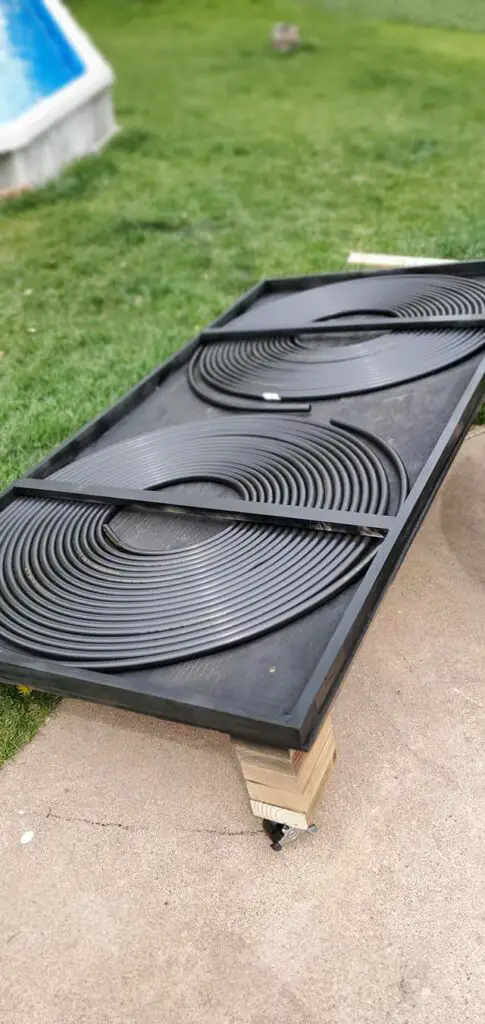

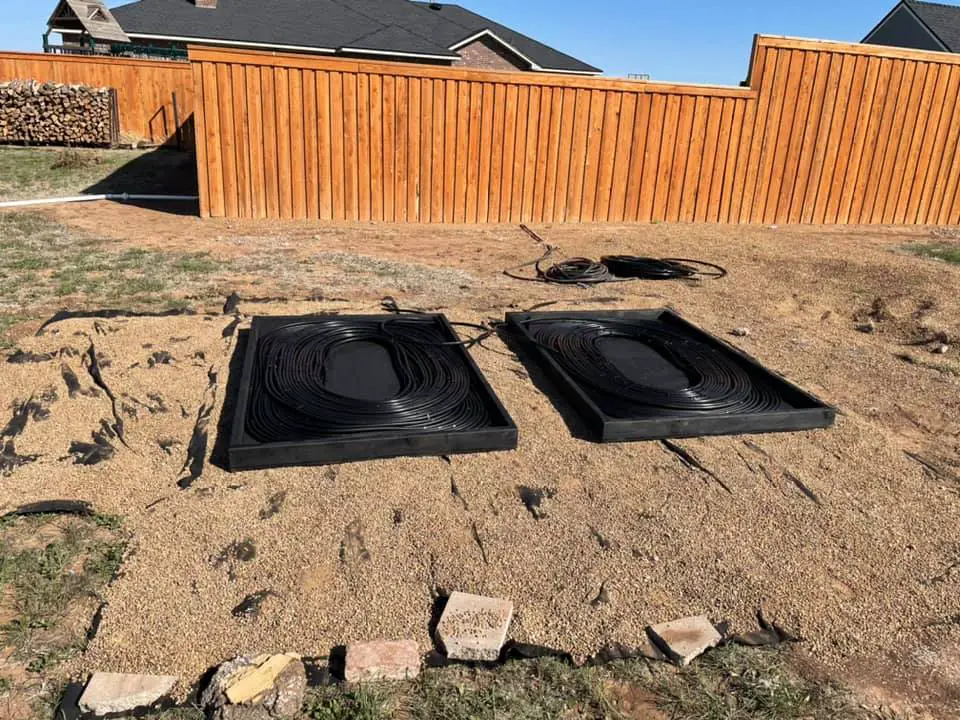
HOW DOES A SOLAR HEATER WORK?
With living and working on pools in Central Florida for thirty-six years, I have seen a lot of solar units. Some systems for inground pools can be fairly complex, but in the end, the way they work is very simple.
A solar system for swimming pools is nothing more than long, small tubes all connected together and attached to the pool’s plumbing. The long tubes are tightly coiled and set out flat on a panel to form one plane.
This flat solar panel (full of tubes) is then placed where it can get a lot of direct exposure to the sun. These tubes are usually black and get very hot during the day.
The pool’s pump sends pool water through these tubes. As the water flows through the tubes, it is heated up by being exposed to the sun. The hot water then moves back to the pool and makes it warmer.
Water continues to flow from the pool, through the tubes, and back to the pool. This can raise the overall water temperature of the pool.
If you are not sure what I mean here, think of your water hose sprawled out across your yard and partially in the sun. When you first turn the spigot on, the water coming out of the hose is very hot. After it runs a while, the water starts to come out cool again.
This is because the hose in the yard got hot from being in the sun and the first gallons of water running through it heated up. The heat is transferred from the hose to the water.
TIPS FOR MAKING A SOLAR HEATER WORK BETTER FOR AN ABOVE GROUND POOL
Solar heating systems for inground pools are expensive and usually set up on the roof of the house. They are also configured and installed professionally for maximum efficiency, and that is partially what you are paying for.
With above-ground pools, solar heating is almost always not professionally installed or configured. Here then are some tips to having one that will work well.
Tip #1 More Panels are Better
Just like with capturing any solar energy, the more surface area, the better.
Probably the biggest “fail” with solar heating for above-ground pools is that there aren’t enough panels or units. Some think that if they buy only one or two panels that it will heat their pool. Yeah, no.
For inground pools, the number of solar panels needed and installed is determined by how much surface the pool has. The more swimming surface to heat up, the more panels of exposed tubing to the sun.
Again, for inground pools, a perfect system would have 100% coverage, which means there is as much square footage of solar panels as there is pool surface.
With above-ground pools, 100% coverage is almost never achieved. This is due to the cost and room in the yard. Installing solar panels on the roof of the house and then plumbing them to the above-ground pool equipment is very rare.
Most above-ground pool solar panels are set up in the yard. And they are ugly and take up a lot of space. This is why you rarely see 100% panel coverage for above grounds.
For most reading this, just consider that more solar panels will heat the pool more. You may not come close to having the same amount of square feet of solar panels as the pool’s surface, but adding more if you can will help a lot.
Tip #2 Direct Exposure to the Sun is Crucial
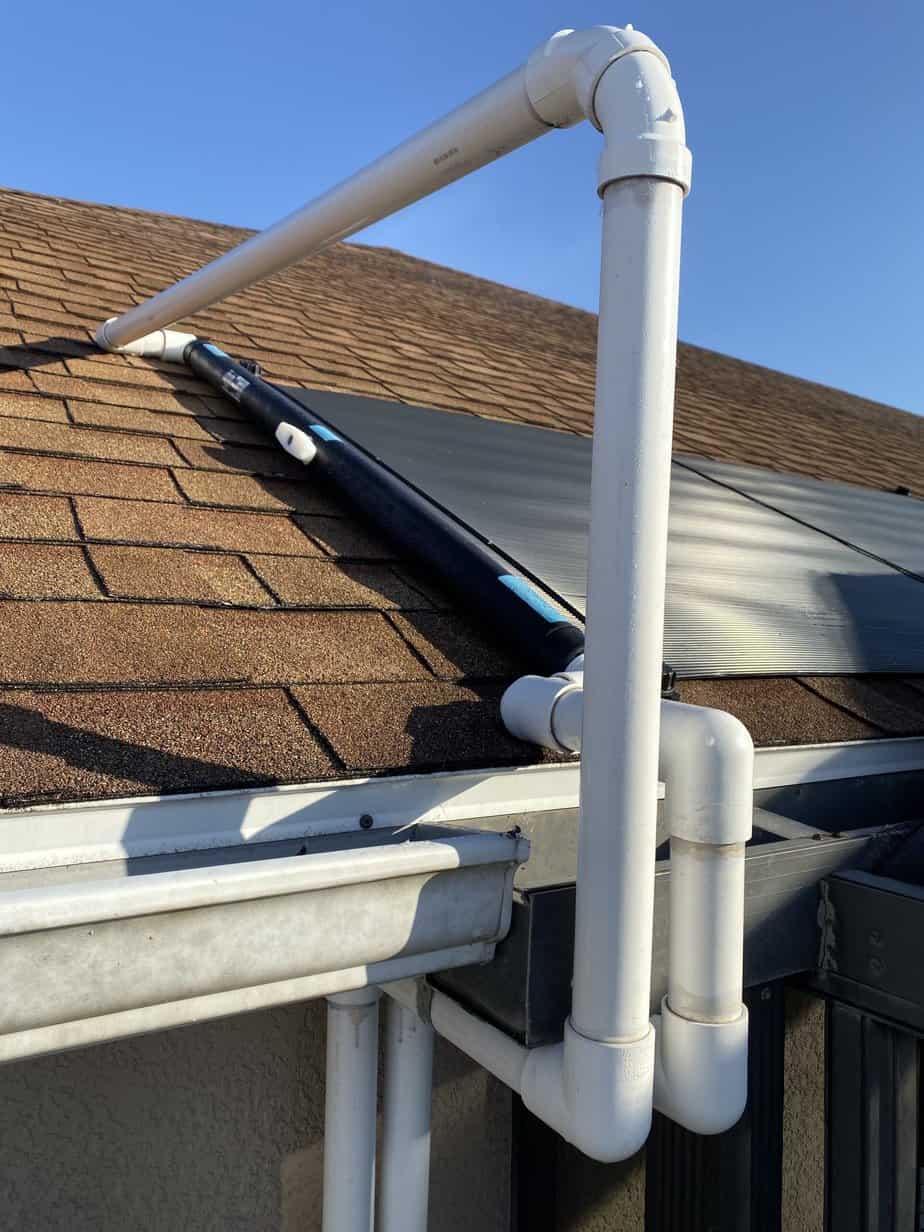
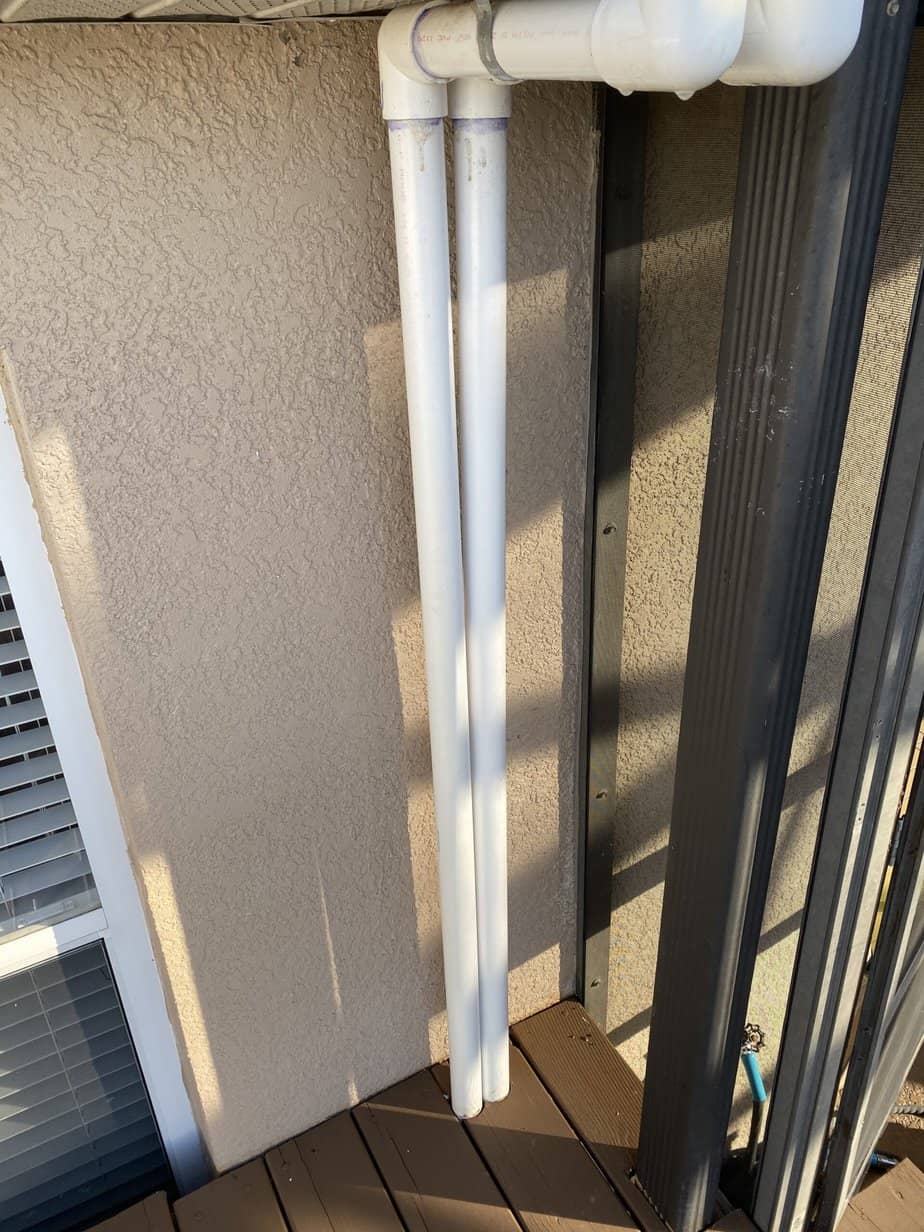
Think you can put your solar panels under a tree in the corner of your yard and it still heat the water? Yeah, nope. Fail!
The black tubes in a solar heater must be exposed to the direct sun. Period. And the more exposure it gets, the more it will heat the water.
Many pool owners don’t want ugly solar panels placed in the middle of the yard and who can blame them? Unfortunately though, if that’s where the “heat of the day” direct sunlight is, then that is the ideal placement for the panels.
Over the years, I have seen many, many people put their solar panels in shady areas of the yard thinking that it will give them some heat. They find out quickly that panels in the shade are a total waste of space, time, and money.
If you don’t have an open area to put solar panels, then don’t bother getting a solar heater. It won’t work.
Tip #3 Tilt the Solar Panels Towards the Sun
Most above-ground pool solar heater units come as a flat panel. These panels are often just placed flat on the ground, in the sun, and next to the pool’s equipment. This is ok but not usually ideal.
The sun travels across the sky at an angle in reference to your property. Directing the panels at a slight angle to the line the sun travels will allow the panels to heat up better.
It’s a pain to make up something to raise and tilt solar panels, but it may be worth it as they will work better at the proper angle to the sun. Tilting the panels south is usually the best direction for most applications.
Tip #4 Lower your Expectations
Even in the most ideal situations, a solar heater will only heat the pool so much.
With the proper amount of panels (exposed surface) in good direct sunlight, you should only expect an increase of about 10 degrees Fahrenheit over what the water temp would be naturally. You may get more if using a solar cover at night and can build on the overall water temp over many clear hot days.
As a pool guy, I’ve heard some crazy things. Recently in my Facebook group for above-ground swimming pools, a guy said he raised his pool’s temperature by twenty degrees over two days just by putting on a solar blanket (and no solar heater). Yeah, that’s fake news for sure.
When I had a pool service company, there were some solar heaters that worked very well. But they were in the most ideal situation with the correct amount of panels on a roof with southern exposure and a shallow pool. Most just raised the pool 10-15 degrees Fahrenheit, which is nice.
Just only expect a solar heater to take the edge off and you’ll be happy with it.
Tip #5 You Must use a Solar Cover
The heat captured in the pool from the sun with a solar heating system can quickly transfer out if the outside temperature is cooler. This happens especially at night when things cool down.
Having a solar blanket on the pool will help keep the heat in. This is because the solar cover is an insulator, which slows down the transference of energy in a temperature change.
A solar cover does not help heat the water though, so don’t think that. Learn about solar covers here
Tip #6 Solar Panels aren’t Durable. Protect Them
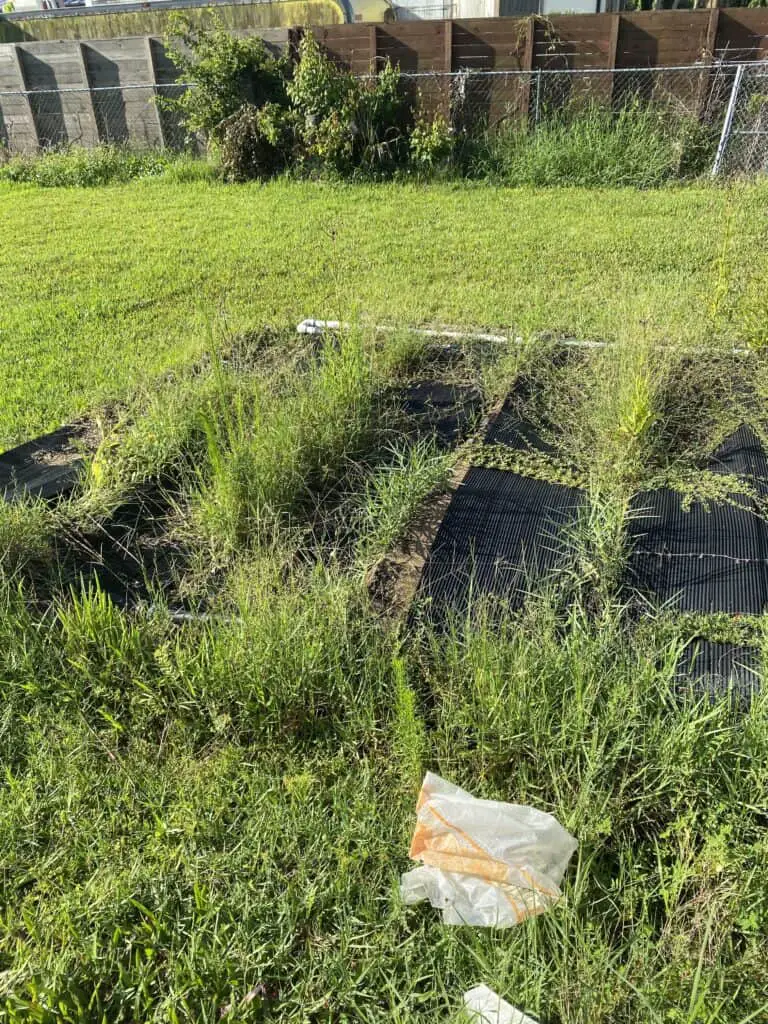
Everything that is made for above-ground pools has to be cost-effective. This is because above-ground pools are a much less expensive alternative to ingrounds, and therefore have to have an overall much less cost with things associated with them.
Solar heating units for above grounds are not high quality. They also don’t cost much either.
Solar panels take a lot of abuse. Direct sunlight is no joke and will take life off of most things. Since solar panels have to be in direct sunlight, they often will fail by leaking sooner than later.
Taking care of your panels will help. Make sure they stay clean of any debris and don’t allow animals to crawl on them or kids to mess with them. If on the ground, regularly inspect for ant piles and other things making homes under or one them.

If I have 100-150% of pool size of solar heaters for a 4 foot 5000 gallon pool,plus a heat pump, both 100 feet from the pump and pool, is a 1 1/2 HP pump appropriate, or am I pushing the water through the pool too fast?
Should I plumb it to go though solar heaters first then to heat pump, during hot hours? I am aiming for 90 degrees.
Thank you.
It sounds like you have plenty of heating power.
I would put a valve in towards the solar panels and back off some flow to get the right amount. Problem there is you’ll want to be able to know what the water temp is exiting the panels so you can dial-in the flow amount.
I don’t think it matters who heats the water first. For me, it would depend on where the components are and how best to plumb them together and in the system. You always want plumbing to be as simple as possible. You don’t want your plumbing to look like Japanese freeway system. lol
I think you’ll find that the heat pump is all you need.